
Korean Currency and Culture: What Visitors Should Know
Travelers visiting South Korea will use Korean currency during their trip. The currency is called the Korean won, and its symbol is ₩, with the currency code KRW. The exchange rate is approximately 1,300 KRW to 1 USD. If you're planning to visit South Korea, take a look at the 'Hidden Stories in Korean Won Bills and coins' to learn about the cultural histories and contexts behind the figures featured on the banknotes and coins you'll be using every day.
Korean Currency Name, Symbol and Code
Currency Name: Won
Currency Symbol: ₩
Currency Code: KRW
Denominations:
| 10 KRW | 50 KRW | 100 KRW | 500 KRW |
|---|---|---|---|
| 0.01 USD | 0.04 USD | 0.08 USD | 0.38 USD |
| 1,000 KRW | 5,000 KRW | 10,000 KRW | 50,000 KRW |
|---|---|---|---|
| 0.8 USD | 3.85 USD | 7.69 USD | 38.46 USD |
I'm estimating the exchange rate at around 1 US Dollar = 1,300 KRW. But it's best to check the current rate prior to your trip, just in case it changed a little from day to day.
Hidden Stories in Korean Won Bills
⭕ KRW 50,000 banknote: This is the highest denomination of banknote currently in circulation in Korea. It was most recently issued in 2009. The 50,000 won note features the only female figure depicted on modern South Korean currency.
Figure: Shin Saimdang (1504-1551), a 16th-century poet, painter, and scholar during the Joseon Dynasty. She was the mother of Yi I, who is featured on the KRW 5,000 note.
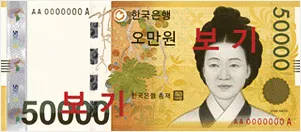
- Shin Saimdang's painting, 'Grape', Kansong Art and Culture Foundation.
- Shin Saimdang's painting, 'Grass and Insects', Dong-A University Museum.

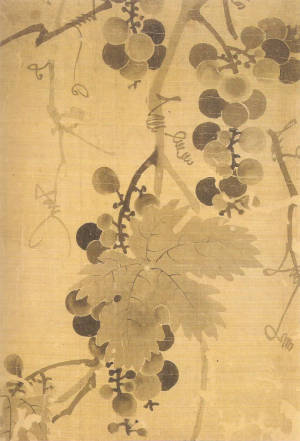
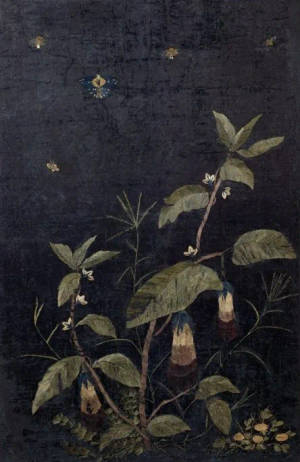
© Kansong Art and Culture Foundation
© Seokdang Museum of Dong-A University
She was renowned for her artistic talent from a young age. There's a story that one of her paintings of insects was so realistic that a chicken mistook it for real bugs and pecked at the painting, thinking it was eating real insects.
On the back, two Joseon Dynasty artworks are displayed vertically, introducing a vertical layout unseen on previous banknotes.
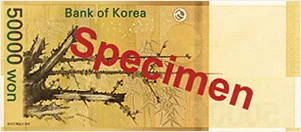
- Eo Mong-ryong's (어몽룡, 1566-1617) Wolmedo (월매도), National Museum of Korea.
- Lee Jeong's (이정, 1554-1626) Bamboo (풍죽도), Kansong Art and Culture Foundation.

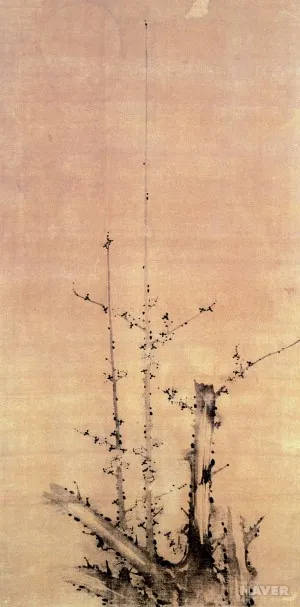

Eo Mong-ryong's Wolmedo © term.naver
Lee Jeong's Bamboo © Kansong Art and Culture Foundation
😲 Behind Story: In 2007, the Bank of Korea prepared to issue new 100,000 and 50,000 won banknotes. However, due to concerns about inflation, counterfeiting, and potential misuse, the 100,000 notes were cancelled before being issued.
At the time, there were no women depicted on South Korean banknotes, even though gender equality had become a major public issue. It was decided that one of the two new planned banknotes should feature a prominent female figure.
After considering various historic Korean women, artist Shin Saimdang was chosen. However, some argued that while recognized as a talented artist, Shin Saimdang's image emphasized her domestic roles as a wife and mother. They felt the first woman on a Korean banknote should represent the diverse accomplishments of women beyond traditional gender expectations.
⭕ KRW 10,000 banknote: It is often referred to as the "cabbage leaf" due to its green color.
Figure: King Sejong (세종대왕, 1397-1450), the fourth king of the Joseon Dynasty, a highly regarded monarch who advanced science and the arts, and created Korea's alphabet, Hangul (한글).
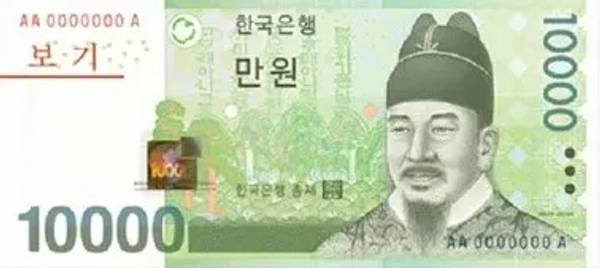
- Ilwol-Obongdo (Sun and Moon and Five Peaks): The painting placed behind the throne symbolizes the universe with its symmetric composition and empty center where only the king may sit. The painting itself came to represent the king. It is displayed at the National Palace Museum of Korea, located next to Gyeongbokgung Palace.
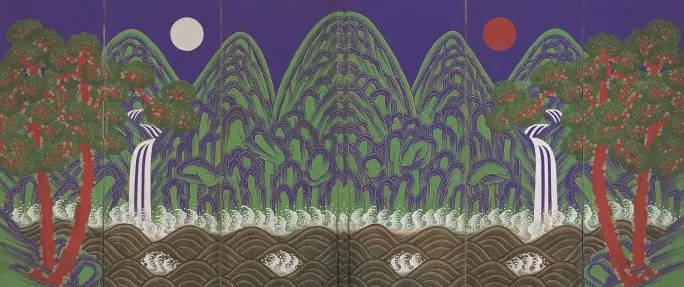
Ilwol-Obongdo (Sun and Moon and Five Peaks) © term.naver
- Yongbieocheonga (Song of Dragons Flying in Heaven): The first book written in Hangul, created by King Sejong to test how well Hangul could represent the Korean language before it was officially promulgated. It sings the legitimacy of the founding of the Joseon Dynasty.
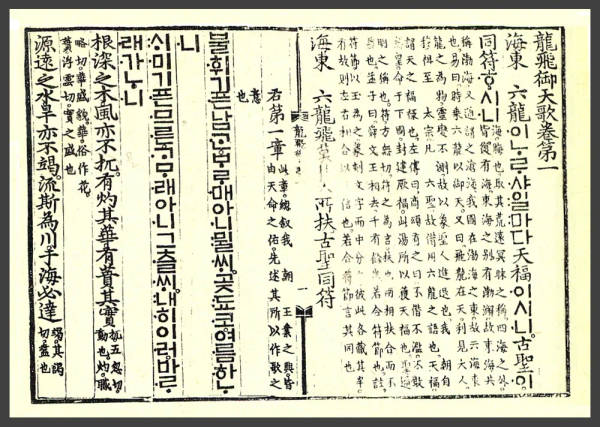
Yongbieocheonga (Song of Dragons Flying in Heaven)

Armillary Sphere (혼천의): Astronomical Observing Instrument Created During the Joseon Sejong Era.
Cheonsangyeolchabunyajido (천상열차분야지도): The world's oldest astronomical chart depicting the entire sky, featuring 1,467 stars with variations in star size to represent their brightness. It is also displayed at the National Palace Museum of Korea, located next to Gyeongbokgung Palace.
- Bohyunsan Optical Astronomy Observatory (보현산 천문대 만원경): The largest optical research telescope in the country, with a primary mirror diameter of 1.8 meters.
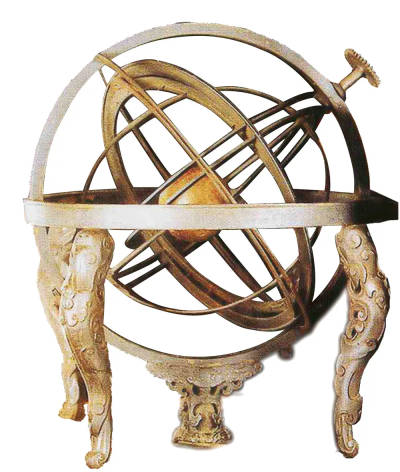

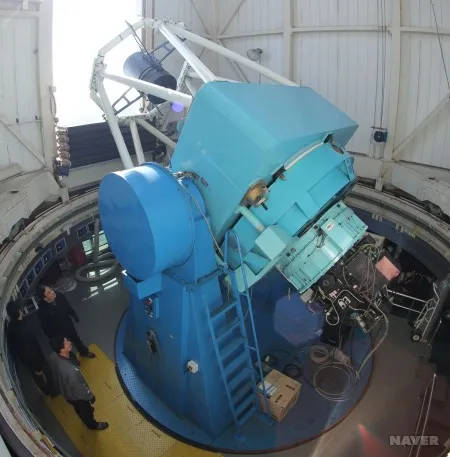
Cheonsangyeolchabunyajido © terms.naver
Bohyunsan Optical Astronomy Observatory © naver.terms
⭕ KRW 5,000 banknote
Figure: Yi I (이이, 1537-1584), a prominent Neo-Confucian scholar of the Joseon Dynasty in Korea who actively worked to reform society and politics. He was the son of Shin Saimdang, featured on the KRW 50,000 banknote.
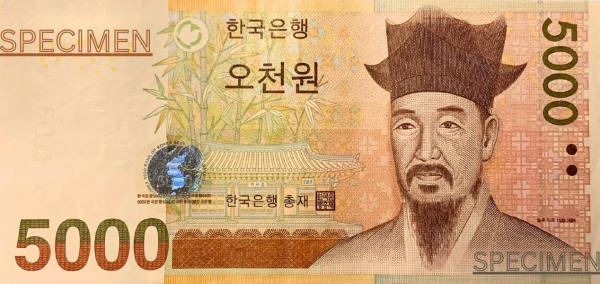
Ojukheon House: The birthplace and childhood home of philosopher Yi I, located in Gangneung. On the back are depicted five bamboo trees. 'Ojuk' translates to five bamboo trees, referring to the location near a grove of five bamboo.
Yi I was born in the Mongryongsil room of the house. Prior to giving birth, his mother Shin Saimdang dreamt of a dragon, so she named the room Mongryong which means "dragon dream."
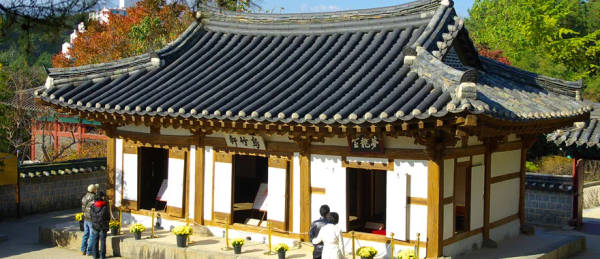
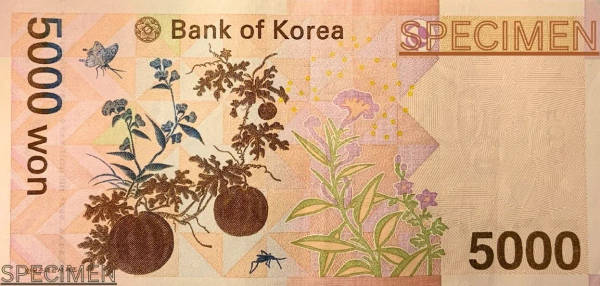
On the back are two works from Shin Saimdang's famous 'Grass and Insects' painting series - 'Grapes' and 'Cockscomb'.
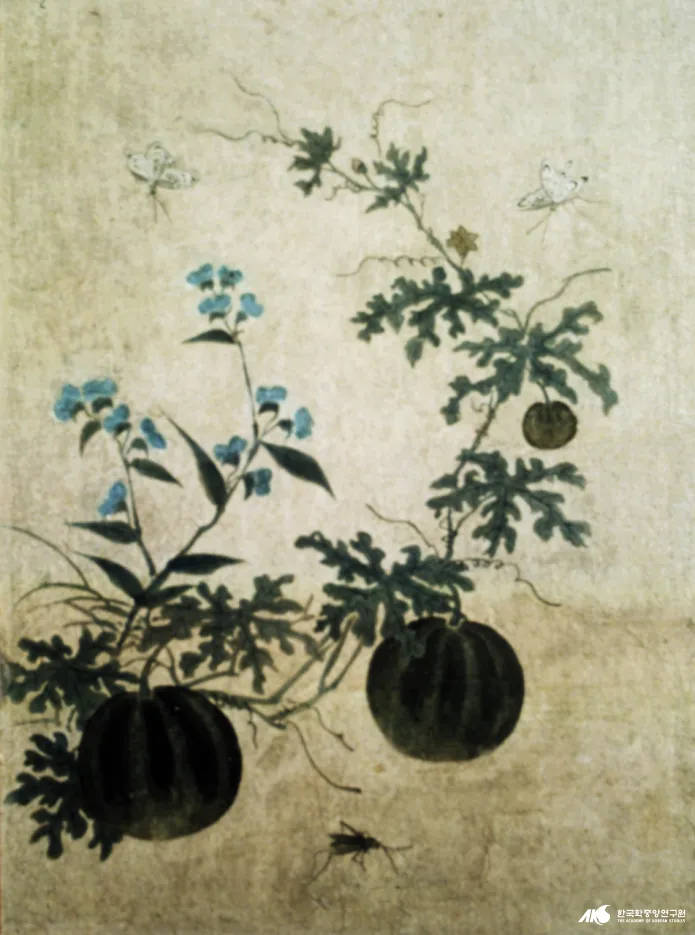
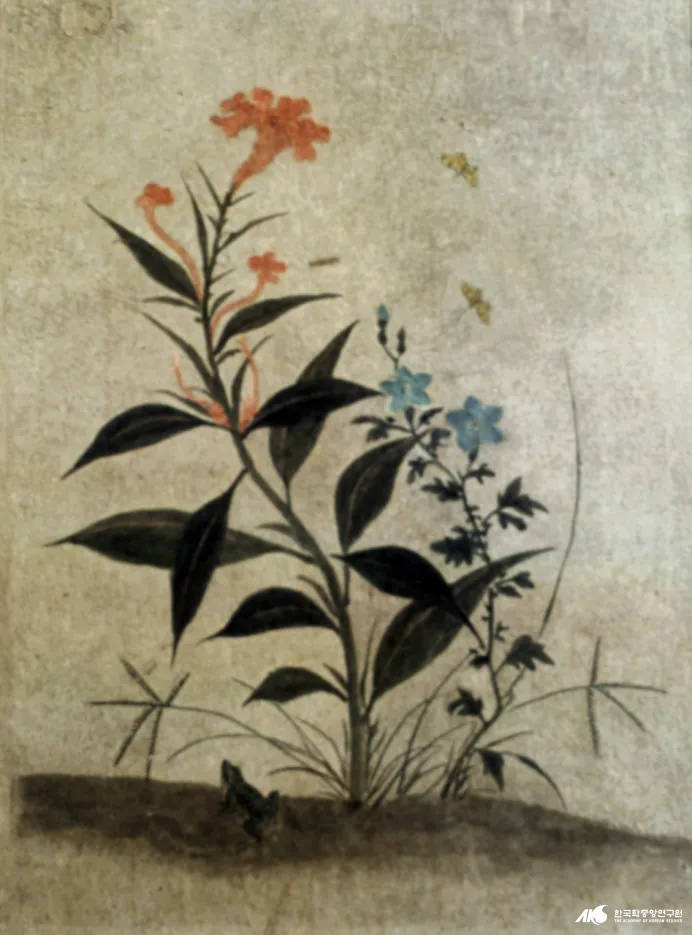
⭕ KRW 1,000 banknote
Figure: Yi Hwang (이황, 1502-1571), a leading Neo-Confucian scholar of the Joseon dynasty of Korea. He developed theories of Neo-Confucianism and dedicated himself to educating subsequent generations of scholars and advancing academic pursuits.
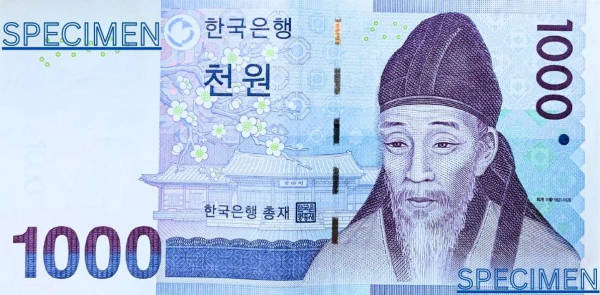
Plum Blossoms: These were Yi Hwang's favorite flowers. During the intense grief of losing his wife and son, a woman comforted and cared for him, and they fell in love.
When Yi Hwang had to relocate for a new post and leave that place, the parting gift from that woman was the plum blossoms. Even after relocating for his new post, he took meticulous care of the plum blossoms until his final days. It's said that his last words, just before passing away, were "water the plum blossoms."
Myeongnyundang: The lecture hall where students of the Seonggyungwan Confucian academy gathered to study. Yi Hwang served as the headmaster and taught Confucianism to the students. This was the predecessor institution to today's Seonggyungwan University.
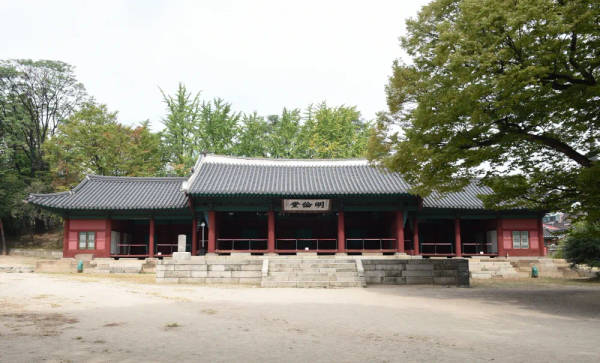
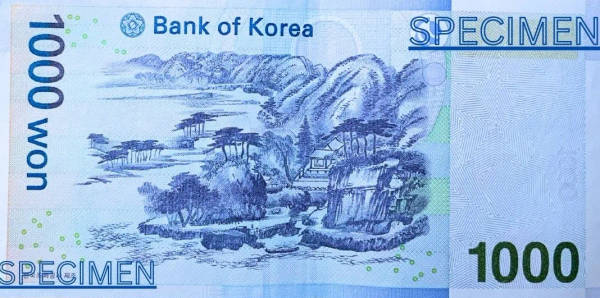
Jeong Seon's (정선, 1676-1759) "Gyesangjeonggo Painting": Gyesangjeonggo, meaning to quietly stay by the river, depicts Gyesan Seowon (Seowon means local academy), where Yi Hwang resided. On closer inspection, the painting portrays a scholar, presumably Yi Hwang, seated in the seowon.
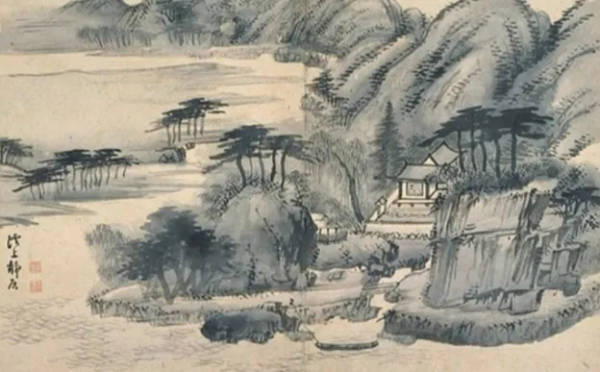
Hidden Stories in Korean Coins
⭕ KRW 500 Coin: Issued in 1982. Prior to then, the 500 won was also a bill. A crane is depicted. In Korea, cranes have long symbolized longevity, high-minded scholars, and were considered sacred animals that accompany immortals.The image of the crane in flight also expresses hopes for Korea's leaping economy and its soaring presence within the international community.

⭕ KRW 100 Coin: First issued as a coin starting in 1970.
Figure: Yi Sun-sin (이순신, 1545-1598), a prominent general during the Joseon Dynasty of Korea who led naval forces to great victory over Japan during the 7-year Imjin War. He is celebrated as one of Korea's greatest national heroes. His statue can be seen at Gwanghwamun Square in Seoul.
A model of the turtle ship he designed is on display at the Seoul War Memorial of Korea.

⭕ KRW 50 Coin: Features an image of rice grains. It was first made in 1972 as part of the "FAO Coin Program" established by the UN's Food and Agriculture Organization (FAO) in 1968.
The program recommended that countries create coins commemorating "World Food Day." Korea participated in this initiative by symbolizing Koreans' main staple crop of rice with the depiction of grains on the 50-won coin.
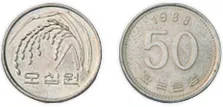
⭕ KRW 10 Coin: Features an image of the Dabotap pagoda located at Bulguksa Temple in Gyeongju. Bulguksa Temple was constructed in 751 CE during the Unified Silla period. The Dabotap pagoda is designated as National Treasure No. 21.

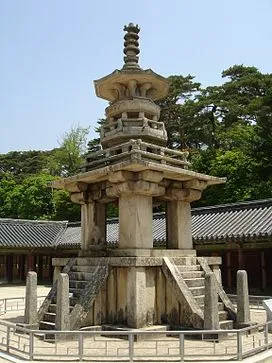
Wrap-up
Visitors traveling to South Korea will use Korean won bills during their trip. The portraits, symbols and artwork featured on the nation's banknotes and coins represent an integral part of Korean culture and history.
On Korean currency, you'll find depictions of specific figures such as an artist, a king, two scholars, a general, a bird, a grain, and a pagoda across different denominations. I've linked reviews to places related to these figures, and I highly recommend visiting those locations.